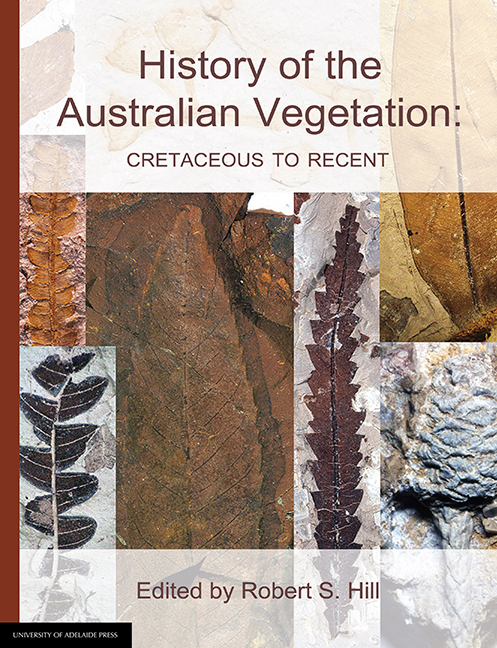Book contents
- Frontmatter
- Contents
- List of contributors
- Introduction to the 2017 edition
- 1 The Australian fossil plant record: an introduction
- 2 Maps of late Mesozoic-Cenozoic Gondwana break-up: some palaeogeographical implications
- 3 The background: 144 million years of Australian palaeoclimate and palaeogeography
- 4 Palaeobotanical evidence for Tertiary climates
- 5 Landscapes of Australia: their nature and evolution
- 6 Patterns in the history of Australia's mammals and inferences about palaeohabitats
- 7 Australian Tertiary phytogeography: evidence from palynology
- 8 Cretaceous vegetation: the microfossil record
- 9 Cretaceous vegetation: the macrofossil record
- 10 Early Tertiary vegetation: evidence from spores and pollen
- 11 The early Tertiary macrofloras of continental Australia
- 12 Cenozoic vegetation in Tasmania: macrofossil evidence
- 13 The Neogene: a period of transition
- 14 The Oligo-Miocene coal floras of southeastern Australia
- 15 Quaternary vegetation
- 16 The history of selected Australian taxa
- Taxonomic index
- General index
12 - Cenozoic vegetation in Tasmania: macrofossil evidence
Published online by Cambridge University Press: 25 July 2017
- Frontmatter
- Contents
- List of contributors
- Introduction to the 2017 edition
- 1 The Australian fossil plant record: an introduction
- 2 Maps of late Mesozoic-Cenozoic Gondwana break-up: some palaeogeographical implications
- 3 The background: 144 million years of Australian palaeoclimate and palaeogeography
- 4 Palaeobotanical evidence for Tertiary climates
- 5 Landscapes of Australia: their nature and evolution
- 6 Patterns in the history of Australia's mammals and inferences about palaeohabitats
- 7 Australian Tertiary phytogeography: evidence from palynology
- 8 Cretaceous vegetation: the microfossil record
- 9 Cretaceous vegetation: the macrofossil record
- 10 Early Tertiary vegetation: evidence from spores and pollen
- 11 The early Tertiary macrofloras of continental Australia
- 12 Cenozoic vegetation in Tasmania: macrofossil evidence
- 13 The Neogene: a period of transition
- 14 The Oligo-Miocene coal floras of southeastern Australia
- 15 Quaternary vegetation
- 16 The history of selected Australian taxa
- Taxonomic index
- General index
Summary
The Tasmanian Cenozoic macrofossil record is relatively rich, and changes that have occurred in the vegetation of the region are becoming increasingly well understood. The record is essentially one of rainforest elements, especially in the Paleogene, but taxa that are now common in sclerophyllous heathlands and woodlands are increasingly prevalent in Quaternary sediments.
Extant Tasmanian rainforest is renowned for its beauty, and botanists have long recognised its marked taxonomic and structural similarity to other southern hemisphere ‘cool temperate’ forests of New Zealand and Chile. These are generally dominated by Nothofagus trees, their boughs laden with lichens and verdant shrouds of bryophytes. Other links are often made by phytogeographers to similar forests in high altitude regions of northern New South Wales and the much more species-rich vegetation of the generally montane regions of New Guinea and New Caledonia where Nothofagus also grows. A striking aspect of these forests is the presence of a variety of conifers, principally Podocarpaceae, but also Cupressaceae and Araucariaceae. In Tasmania the Araucariaceae are extinct, but the region is unique in the southern hemisphere in having a genus of Taxodiaceae, Athrotaxis. Athrotaxis spp. are often associated with Australia's only winter deciduous plant, Nothofagus gunnii, in montane regions of the island. The macrofossil record shows conclusively that the current diversity of Tasmania's woody rainforest flora is very much lower than at any other time during the Cenozoic. It confirms that there are strong floristic links to regions as widespread as eastern and southwestern mainland Australia, southern South America, New Zealand and New Guinea. In fact, Tasmanian Paleogene floras contain a wealth of taxa that are closely related to plants now confined to these regions.
Apart from the relatively large tracts of rainforest in Tasmania, closed forest lacking eucalypts is now confined to small patches along the east coast of Australia. In contrast to mainland Australia, Tasmania is relatively mountainous and has a well-developed woody alpine vegetation, dominated by shrubs of the Asteraceae, Epacridaceae, Myrtaceae and Proteaceae.
- Type
- Chapter
- Information
- History of the Australian VegetationCretaceous to Recent, pp. 276 - 298Publisher: The University of Adelaide PressPrint publication year: 2017



